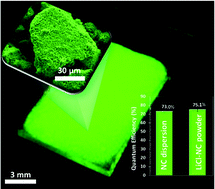Stable and efficient colour enrichment powders of nonpolar nanocrystals in LiCl†
Abstract
In this work, we propose and develop the inorganic salt encapsulation of semiconductor nanocrystal (NC) dispersion in a nonpolar phase to make a highly stable and highly efficient colour converting powder for colour enrichment in light-emitting diode backlighting. Here the wrapping of the as-synthesized green-emitting CdSe/CdZnSeS/ZnS nanocrystals into a salt matrix without ligand exchange is uniquely enabled by using a LiCl ionic host dissolved in tetrahydrofuran (THF), which simultaneously disperses these nonpolar nanocrystals. We studied the emission stability of the solid films prepared using NCs with and without LiCl encapsulation on blue LEDs driven at high current levels. The encapsulated NC powder in epoxy preserved 95.5% of the initial emission intensity and stabilized at this level while the emission intensity of NCs without salt encapsulation continuously decreased to 34.7% of its initial value after 96 h of operation. In addition, we investigated the effect of ionic salt encapsulation on the quantum efficiency of nonpolar NCs and found the quantum efficiency of the NCs-in-LiCl to be 75.1% while that of the NCs in dispersion was 73.0% and that in a film without LiCl encapsulation was 67.9%. We believe that such ionic salt encapsulated powders of nonpolar NCs presented here will find ubiquitous use for colour enrichment in display backlighting.


 Please wait while we load your content...
Please wait while we load your content...